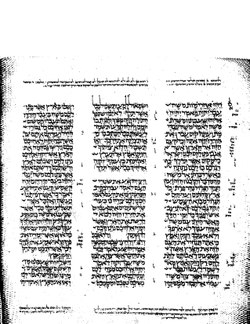Joshua 22
| Joshua 22 | |
|---|---|
 The pages containing the Book of Joshua in Leningrad Codex (1008 CE). | |
| Book | Book of Joshua |
| Hebrew Bible part | Nevi'im |
| Order in the Hebrew part | 1 |
| Category | Former Prophets |
| Christian Bible part | Old Testament |
| Order in the Christian part | 6 |
Joshua 22 is the twenty-second
Text
This chapter was originally written in the Hebrew language. It is divided into 34 verses.
Textual witnesses
Some early manuscripts containing the text of this chapter in Hebrew are of the Masoretic Text tradition, which includes the Codex Cairensis (895), Aleppo Codex (10th century), and Codex Leningradensis (1008).[7]
Extant ancient manuscripts of a translation into Koine Greek known as the Septuagint (originally was made in the last few centuries BCE) include Codex Vaticanus (B; B; 4th century) and Codex Alexandrinus (A; A; 5th century).[8][a]
Analysis

The narrative of Israelites preparing for life in the land comprising verses 22:1 to 24:33 of the Book of Joshua and has the following outline:[10]
- A. The Jordan Altar (22:1–34)
- 1. Joshua's Charge to the East Jordan Tribes (22:1–8)
- 2 The Construction of the Altar and a Possible Civil War (22:9–12)
- 3. Meeting Between Phinehas and the East Jordan Tribes (22:13–29)
- a. Phinehas Challenges the East Jordan Tribes (22:13–20)
- b. The East Jordan Tribes Explain (22:21–29)
- 4. Phinehas Returns to the West (22:30–32)
- 5. The Altar Named (22:33–34)
- B. Joshua's Farewell (23:1–16)
- C. Covenant and Conclusion (24:1–33)
The altar by the Jordan (22:1–12)
Still at
The Altar of Witness (22:13–34)
The case against the two and a half tribes is outlined in terms of holiness requirements (verses. 13–20), so the priest Phinehas (son of Eleazar), rather than Joshua, was sent to talk to those tribes.[11] The alleged sin from building the altar, whether it might make the land across the Jordan to be ritually 'unclean', and therefore unfit for worship (verse 19)., is compared with two other sins in the religious realm (verses 17, 20):[11]
It is the duty of all Israel, as a religious assembly or congregation,to pursue the errant tribes (verses 12, 16).[11]
The Transjordan tribes responded by recognizing the unique claims of both YHWH and his altar (22:21–29) using the phrase 'The LORD, God of gods' ('
See also
- Bashan
- Blessing
- Brass
- Canaan
- Cattle
- Children of Israel
- Ed (altar)
- Gift offering
- Gilead
- Gold
- Iron
- Jordan River
- Kohen
- Korban
- Levite
- Moses
- Silver
- Slaughter offering
- Tabernacle
- Tribe of Gad
- Tribe of Manasseh
- Tribe of Reuben
- Zerah
- Related Bible parts: Numbers 32, Joshua 1
Notes
- ^ The whole book of Joshua is missing from the extant Codex Sinaiticus.[9]
References
- ^ Halley 1965, p. 164.
- ^ Talmud, Baba Bathra 14b–15a)
- ^ a b Gilad, Elon. Who Really Wrote the Biblical Books of Kings and the Prophets? Haaretz, June 25, 2015. Summary: The paean to King Josiah and exalted descriptions of the ancient Israelite empires beg the thought that he and his scribes lie behind the Deuteronomistic History.
- ^ Coogan 2007, p. 314 Hebrew Bible.
- ^ Coogan 2007, pp. 347–349 Hebrew Bible.
- ^ McConville 2007, p. 158.
- ^ Würthwein 1995, pp. 35–37.
- ^ Würthwein 1995, pp. 73–74.
- ^
 This article incorporates text from a publication now in the public domain: Herbermann, Charles, ed. (1913). "Codex Sinaiticus". Catholic Encyclopedia. New York: Robert Appleton Company.
This article incorporates text from a publication now in the public domain: Herbermann, Charles, ed. (1913). "Codex Sinaiticus". Catholic Encyclopedia. New York: Robert Appleton Company.
- ^ Firth 2021, pp. 30–31.
- ^ a b c d e f g h McConville 2007, p. 173.
Sources
- Beal, Lissa M. Wray (2019). Longman, Tremper III; McKnight, Scot (eds.). Joshua. The Story of God Bible Commentary. Zondervan Academic. ISBN 978-0310490838.
- ISBN 978-0195288810.
- Firth, David G. (2021). Joshua: Evangelical Biblical Theology Commentary. Evangelical Biblical Theology Commentary (EBTC) (illustrated ed.). Lexham Press. ISBN 9781683594406.
- ISBN 0-310-25720-4.
- Harstad, Adolph L. (2004). Joshua. Concordia Publishing House. ISBN 978-0570063193.
- Hayes, Christine (2015). Introduction to the Bible. Yale University Press. ISBN 978-0300188271.
- Hubbard, Robert L (2009). Joshua. The NIV Application Commentary. Zondervan. ISBN 978-0310209348.
- McConville, Gordon (2007). "9. Joshua". In ISBN 978-0199277186. Retrieved February 6, 2019.
- Rösel, Hartmut N. (2011). Joshua. Historical commentary on the Old Testament. Vol. 6 (illustrated ed.). Peeters. ISBN 978-9042925922.
- ISBN 9780802826282.
- ISBN 0-8028-0788-7. Retrieved January 26, 2019.
External links
- Jewish translations:
- Yehoshua - Joshua - Chapter 22 (Judaica Press). Hebrew text and English translation [with Rashi's commentary] at Chabad.org
- Christian translations:
- Online Bible at GospelHall.org (ESV, KJV, Darby, American Standard Version, Bible in Basic English)
- Joshua chapter 22. Bible Gateway

